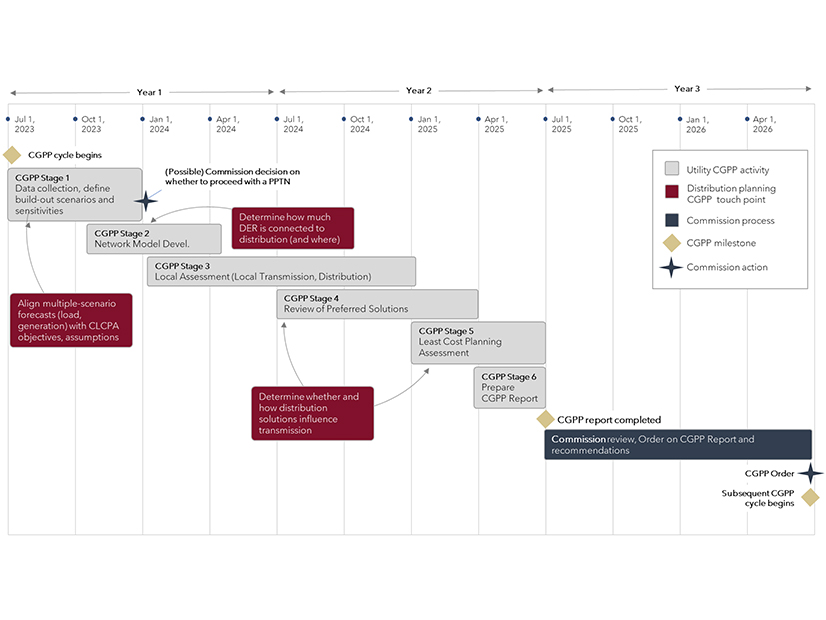Stakeholders told the New York Public Service Commission it should modify utilities’ proposed transmission planning framework, saying the plan lacks independence and could favor local upgrades over more efficient regional projects (20-E-0197).
In December, seven utilities proposed their Coordinated Grid Planning Process (CGPP) in response to the PSC’s May 2020 order requiring the companies to develop distribution and local transmission upgrades to help meet the renewable energy targets of the Climate Leadership and Community Protection Act (CLCPA). (See NY Utilities Propose Plan to Coordinate Decarbonization Efforts.)
The PSC received comments from about 20 agencies, companies, nonprofits and trade coalitions. They said the CGPP’s timeframe does not match NYISO processes and that the proposed independent body responsible for advising the PSC lacks diversity. In addition, the methodologies for identifying transmission upgrades appear biased, and advanced technologies were inadequately considered, the commenters said.
Independence of Advisory Group
Stakeholders said the utilities’ proposed make-up of the Energy Policy Planning Advisory Council (EPPAC) would make it a vessel for expanding utility interests.
As proposed, the EPPAC would include a representative and an alternate from each utility, Department of Public Service staff, NYISO, the New York State Energy Research and Development Authority, renewable generation and storage associations, power authorities (New York Power Authority, Long Island Power Authority) and environmental justice community associations.
New York City was forceful on this, writing that the EPPAC “creates an inherent conflict” because of how much control the utilities would have over its processes. It is hard to imagine why the council would advance results “inconsistent with their views, plans and proposals,” the city said, calling it “mostly a plan for the electric utilities to coordinate among themselves with no requirement to incorporate input from others.”
The New York Power Authority said that the proposed EPPAC leaves some sectors with “a reduced opportunity to provide valuable input.”
NYISO, NYPA, Environmental Defense Fund, the Working for Advanced Transmission Technologies (WATT) Coalition, the “Clean Energy Parties” (including the Alliance for Clean Energy New York, Advanced Energy United and solar and battery organizations) and a joint filing by organizations including the Alliance for Clean Energy New York, the New York Offshore Wind Alliance, Natural Resources Defense Council and the American Clean Power Association (“the Alliance”), argued that the PSC should expand the EPPAC with non-utility members to diversify the council.
Synching with ISO Process
Most commenters also said the CGPP, which operates on a three-year life cycle, is incompatible with NYISO’s two-year public policy transmission planning process for identifying and evaluating necessary transmission upgrades.
The CGPP “would not integrate well with existing NYISO transmission planning processes and would not fully reap the benefits available from competition in the identification and procurement of local and bulk solutions to transmission need,” wrote NYPA.
This was echoed by the CEP, the Alliance and EDF Renewables, which proposed a compromise to reduce CGPP to a two-year cycle but complemented with a PSC review lasting no more than six months.
Threat to Competition
Commentators also complained that the CGPP gives utilities control over public policy transmission need processes, threatening competition.
The CGPP turns the “existing FERC-approved system on its head” and gives utilities opportunities “to displace bulk upgrades with smaller, less efficient local upgrades,” LS Power wrote. It would threaten transmission competition and eliminate consumer benefits “including reduced cost per MW of incremental transfer, increased production cost savings, reduced emissions, and cost containment,” LS said.
“Placing [utilities] in charge of selecting a bulk solution raises potential jurisdictional issues and may create inefficient incentives” wrote NYPA. It warned the utilities’ plan gives them the ability to “favor their own projects rather than exposing transmission needs to competitive selection.”
NYISO said the PSC should “require clear criteria for the prioritization of solutions in a multifaceted planning process,” since this provides the CGPP with “clearer workstreams and avoid a preference for local transmission solutions where a regional solution can more efficiently achieve the CLCPA targets and benefit ratepayers.”
EDFR, the CEP, and the Alliance also highlighted this issue, which they said the PSC could address by encouraging greater flexibility in transmission evaluations and increasing transparency in competitive processes.
Grid-enhancing Technologies
Many commentators also said the CGPP should be more open to future technologies, specifically distributed energy resources and energy storage.
The CGPP does not “adequately incorporate the value of grid enhancing technologies” while the CEP argued the proposal “does not establish a clear, transparent, timely or collaborative process for evaluating and including [new] technologies.”
Transource Energy said that the utilities “limited their recommended list of technologies.” The EDF said CGPP evaluations failed to provide “detailed distribution grid planning that will be needed in New York.”
ECOGY Energy, a Brooklyn-based developer, advised the PSC to require more flexibility at the distribution level to improve long-term planning for future technologies, while Transource said the PSC should add several public review processes within the CGPP cycle to review technologies deployed since the last cycle.
The first CGPP cycle is scheduled to start July 1 and end on July 1, 2025.

